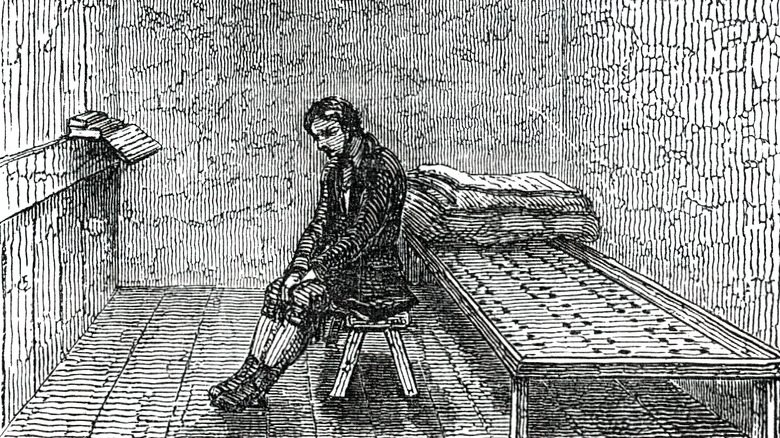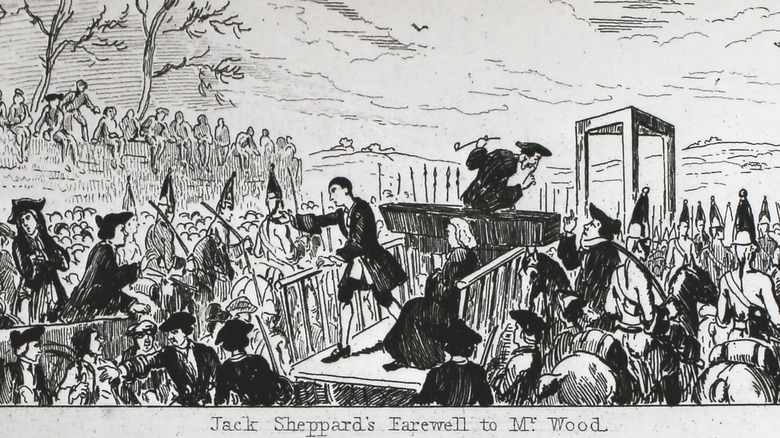Jack Sheppard's Prison Escapes Were Unlike Any We've Ever Seen Before
Jack Sheppard was a young man living in the 17th century with a particular talent for escaping prisons. Per Britannica, Sheppard was born in 1702 in Stepney, England. His father died when Jack was young, and after a few years of working, Jack began to spend time with sex workers and thieves. He fell in love with a sex worker named Elizabeth Lyon. He also started drinking heavily, and began spending more time around Drury Lane, a notoriously crime-filled area in those days, according to "The Complete Newgate Calendar."
Jack Sheppard actually helped someone else break out of prison before he attempted his own escapes. Sheppard tried to visit his partner, Elizabeth Lyon, in prison in 1723. When a guard wouldn't let him in to see her, Sheppard knocked him out, broke through the door, and carried Lyon away from the prison.
Sheppard did complete four years out of a five-year apprenticeship, and was apparently quite talented as a carpenter (per Historic UK). But then he started to commit thefts at the houses he was working at and was arrested for the first time on June 12, 1723, for stealing 118 yards of wool (per "The Proceedings of the Old Bailey," via Rutgers). He was sent to New Prison with Lyon, who happened to be sent to prison around the same time, according to The Complete Newgate Calendar. They convinced a judge that they were a married couple, and were allowed to share a cell.
Creative prison escapes
According to "The Complete Newgate Calendar," after a visit from friends who snuck Sheppard some tools, he spent a few days working on his escape. He filed through his handcuffs, then managed to make a hole in the wall of the cell. He pried wooden and iron bars from the cell's window, and then he and Lyon made their escape. Sheppard stripped the beds, tied together bedsheets and blankets, and formed a rope to lower his partner 25 feet to the ground. He followed behind her. They still weren't out — the two then scaled a wall that was more than 20 feet high, holding onto the locks and bolts to make their getaway.
After some time went by, Sheppard got caught by the law again. This time, he was arrested in August 1724, for the same wool cloth burglary charge he had evaded before — and he was facing a death sentence (per "The Proceedings of the Old Bailey" via Rutgers).
In his cell at Newgate Prison, he filed down a sharp spike in a hatch outside his cell (via "The Complete Newgate Calendar"). Later, two of his friends paid him a visit to help him get out. Sheppard ripped the spike off the wall and shimmied out of the space he'd created. He and his friends avoided the guards, who were drinking down the hall, and got away again. He celebrated his newfound freedom by stealing some watches.
Late night escape
Sheppard is most well known for his final escape in the middle of the night, according to Britannica. He was caught on September 10, 1724 and taken to Newgate Prison.
"Complete Newgate Calendar" reports that by now, prison guards were prepared for Sheppard's arrival. Upon his next incarceration, they put Sheppard in a solitary confinement room called the "Castle." They handcuffed him, put heavy weights on him, and chained the weights to a staple on the floor of the cell. Now a celebrity, Sheppard had tons of visitors, and guards kept a close eye on him to make sure no one snuck him a file or chisel. They couldn't keep Sheppard in — he found a tiny nail and fashioned a lock-picking tool. After a few days, Sheppard found a window of opportunity when his guards were away.
Sheppard picked his handcuffs on October 14, and used the nail to pick the padlock on his cell door. He climbed up the chimney, which was blocked by an iron bar, so he used his chains and a pebble to pry that down. He ascended into an adjacent room — the door to the room had been sealed for seven years, but Sheppard amazingly got past the double-bolted door in less than 10 minutes. He found himself inside the building's chapel, in pitch darkness. The escape artist got to work with an iron spike he broke off the wall, and managed to open the heavy chapel door in about a half-hour.
Sheppard's final days
"Complete Newgate Calendar" reports that by this point, he had been trying to escape for about six hours. Finally, he had just one more door to get through. He made it outside, and climbed a tall wall. Still in his loud jangling chains, Sheppard waited until the town clock chimed 9 p.m. to disguise the sound, then used the iron spike and his prison blanket to slide down the other side. He took a two-hour nap in the attic of a carpenter next door. He wasn't able to get out of his chains for a few more days before he was able to convince someone to buy him the supplies to remove his fetters.
Per Britannica, he went right back to his criminal ways, committing petty theft and drinking heavily. Sheppard just could not stay out of trouble — he got quite drunk and police arrested him yet again. After so many escapes, at this point, Sheppard was considered a local hero (via "The History of the Remarkable Life of John Sheppard").
"Complete Newgate Calendar" reports that Sheppard hoped he could escape one last time — he enlisted some friends to try to revive him after his hanging. But so many people were gathered to see this famous criminal's execution that his friends couldn't get through the crowd; per Britannica, 200,000 people gathered to watch Sheppard's final moments. The famous criminal escape artist did not survive his hanging at Tyburn London, and died on November 16, 1724.



